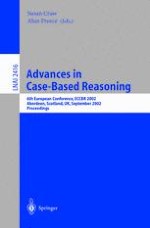The papers collected in this volume were presented at the 6th European C- ference on Case-Based Reasoning (ECCBR 2002) held at The Robert Gordon University in Aberdeen, UK. This conference followed a series of very succe- ful well-established biennial European workshops held in Trento, Italy (2000), Dublin, Ireland (1998), Lausanne, Switzerland (1996), and Paris, France (1994), after the initial workshop in Kaiserslautern, Germany (1993). These meetings have a history of attracting ?rst-class European and international researchers and practitioners in the years interleaving with the biennial international co- terpart ICCBR; the 4th ICCBR Conference was held in Vancouver, Canada in 2001. Proceedings of ECCBR and ICCBR conferences are traditionally published by Springer-Verlag in their LNAI series. Case-Based Reasoning (CBR) is an AI problem-solving approach where pr- lems are solved by retrieving and reusing solutions from similar, previously solved problems, and possibly revising the retrieved solution to re?ect di?erences - tween the new and retrieved problems. Case knowledge stores the previously solved problems and is the main knowledge source of a CBR system. A main focus of CBR research is the representation, acquisition and maintenance of case knowledge. Recently other knowledge sources have been recognized as important: indexing, similarity and adaptation knowledge. Signi?cant knowledge engine- ing e?ort may be needed for these, and so the representation, acquisition and maintenance of CBR knowledge more generally have become important.
